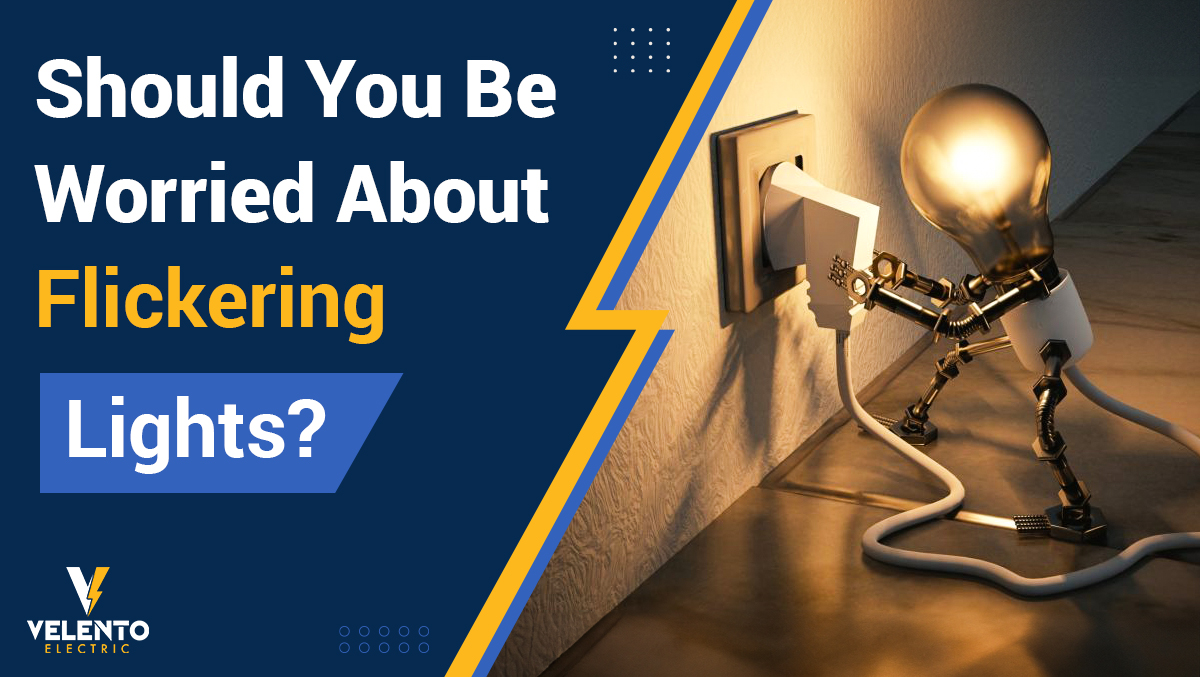Flickering lights can be unsettling and may indicate underlying issues with your electrical system or appliances. While occasional flickering might seem harmless, persistent or severe flickering should not be ignored, as it can be a sign of potential hazards. Here’s what you need to know about flickering lights, their common causes, and when to take action.
Common Causes of Flickering Lights
- Loose or Faulty Bulbs:
- Cause: A loose bulb or a faulty connection within the light fixture can cause intermittent flickering.
- Solution: Ensure the bulb is securely tightened in the socket. If the issue persists, try replacing the bulb to see if that resolves the problem.
- Faulty Light Switches:
- Cause: A worn-out or defective light switch can cause lights to flicker when the switch is toggled or left in a certain position.
- Solution: Test the switch by toggling it on and off. If the flickering stops when the switch is adjusted, replacing the switch may solve the problem.
- Voltage Fluctuations:
- Cause: Large appliances such as air conditioners, refrigerators, or washing machines can cause temporary drops in voltage when they cycle on, leading to light flickering.
- Solution: If lights flicker when these appliances turn on, it might be due to voltage fluctuations. Consider having an electrician check your home’s wiring and circuits.
- Overloaded Circuits:
- Cause: Plugging too many devices into a single circuit can overload it, causing lights to flicker or dim.
- Solution: Redistribute high-power appliances to different circuits to reduce the load on a single circuit.
- Loose Wiring or Electrical Connections:
- Cause: Loose or damaged wiring is a common cause of flickering lights and can pose a significant fire risk if left unaddressed.
- Solution: If flickering is persistent and not tied to a specific appliance, have a licensed electrician inspect your wiring.
- Faulty Circuit Breakers:
- Cause: A failing circuit breaker or fuse can result in inconsistent electrical supply, causing flickering.
- Solution: Circuit breakers may need to be reset, repaired, or replaced if they are causing power issues.
- Electrical Grid Issues:
- Cause: Sometimes, flickering lights are due to issues beyond your home, such as problems with the local power grid or power surges.
- Solution: Contact your utility company if you suspect grid problems. They can verify if there are outages or maintenance work affecting your supply.
- Old or Faulty Light Fixtures:
- Cause: Aging fixtures or wiring can lead to poor connections and flickering lights.
- Solution: Updating old fixtures or having an electrician inspect them can resolve these issues.
When to Be Concerned About Flickering Lights
While occasional flickering is usually not a cause for alarm, certain patterns of flickering can indicate more serious problems. Here’s when you should be particularly concerned:
- Frequent or Persistent Flickering:
If the flickering is happening regularly, it’s likely a sign of a more serious electrical issue that needs immediate attention. - Lights Flicker in Multiple Areas:
If multiple lights across different rooms flicker simultaneously, it could indicate a broader issue, such as problems with your electrical panel or wiring. - Sparks or Burning Smells:
Flickering accompanied by sparks, burning odors, or buzzing sounds is a red flag that could indicate overheating or an impending electrical fire. - Flickering Gets Worse Over Time:
If the flickering becomes more intense or more frequent, this is a clear signal that the problem is escalating and should be addressed promptly. - Lights Flicker When Using High-Power Appliances:
If you notice lights flickering every time you use appliances like the microwave, washing machine, or HVAC system, it suggests an issue with power distribution or an overloaded circuit. - Dimming Alongside Flickering:
Lights that dim significantly when flickering suggest that your home’s electrical system might be struggling to provide consistent power.
Potential Dangers of Ignoring Flickering Lights
- Fire Hazard: Loose connections, faulty wiring, or overloaded circuits can lead to electrical fires if left unresolved.
- Damage to Appliances: Voltage fluctuations can damage sensitive electronics and appliances, shortening their lifespan.
- Electrical Shock Risk: Faulty switches, fixtures, or exposed wiring increase the risk of electrical shock.
Steps to Take When You Notice Flickering Lights
- Identify the Pattern: Determine if the flickering is isolated to a single fixture or if it affects multiple areas of your home.
- Check for Loose Bulbs and Fixtures: Start with the simple fix by checking if bulbs are loose or if the fixture itself has any visible issues.
- Test Appliances and Switches: Pay attention to whether the flickering coincides with the use of specific appliances or light switches.
- Consult an Electrician: If basic troubleshooting doesn’t resolve the problem, or if you notice persistent or severe flickering, consult a licensed electrician for a professional assessment.
- Avoid Overloading Circuits: Spread high-power appliances across different circuits and avoid using multiple heavy-duty devices simultaneously.
- Upgrade Electrical Systems: Older homes may have outdated wiring or panels that struggle to handle modern electrical demands. Consider upgrades for safety and efficiency.
Preventive Measures to Avoid Flickering Lights
- Regular Electrical Inspections: Schedule routine inspections to identify potential issues with your home’s electrical system before they become hazardous.
- Upgrade to LED Bulbs: LEDs are less prone to flickering compared to incandescent or fluorescent bulbs and are more energy-efficient.
- Install Surge Protectors: Protect your appliances from voltage fluctuations and surges by using surge protectors, especially for valuable electronics.
- Replace Old Wiring and Fixtures: Consider replacing outdated fixtures and wiring to improve overall safety and reliability.
Understanding Electrical System Issues
To further understand why flickering lights occur, it’s helpful to look into the components of your home’s electrical system that might be contributing to the problem:
- Electrical Panel (Circuit Breaker Panel):
The panel distributes electricity throughout your home via various circuits. If the panel is outdated, overloaded, or has damaged breakers, it can cause inconsistent power flow, leading to flickering lights. Upgrading an old panel can enhance your home’s electrical capacity and reduce the risk of fires. - Wiring Issues:
Poor or outdated wiring is a common culprit behind flickering lights. This can include frayed wires, corroded connections, or outdated aluminum wiring that poses higher risks of overheating and electrical fires compared to modern copper wiring. Replacing old wiring with updated, safer alternatives can significantly improve your electrical safety. - Grounding Problems:
Proper grounding is essential for safe electrical operation. Grounding issues can cause lights to flicker, as they affect the overall stability of your electrical system. An electrician can inspect grounding rods and connections to ensure your system is properly grounded. - Neutral Wire Issues:
The neutral wire is critical for completing electrical circuits in your home. Problems with the neutral wire, such as loose or disconnected wires, can cause flickering lights and pose serious safety hazards. These issues often require immediate professional attention to prevent electrical shock or fire. - Utility Supply Issues:
Sometimes, flickering lights aren’t due to problems within your home but are caused by issues from the power company. For instance, power surges, faulty transformers, or maintenance work on nearby lines can cause temporary flickering. If you suspect this, contacting your utility provider can clarify if broader issues are at play.
Special Considerations for Specific Situations
- New Home Construction or Remodeling:
If your lights are flickering after a renovation or in a newly built home, ensure that the electrical work was performed to code by licensed professionals. Poor wiring or overloaded circuits during construction can lead to persistent problems. - Older Homes:
Older homes often have outdated electrical systems that were not designed to handle modern appliances and electronics. Upgrading the wiring, electrical panel, and outlets to meet current standards can prevent many common electrical problems, including flickering lights. - Rural Areas or Homes with Private Power Sources:
Homes that rely on private power sources, such as generators or solar power systems, may experience flickering due to inconsistencies in power delivery. Ensuring that these systems are correctly installed and maintained can minimize disruptions. - Seasonal Flickering:
In some regions, flickering lights can be caused by weather-related issues, such as heavy winds affecting power lines, ice build-up, or lightning. Installing whole-home surge protectors can help safeguard your electrical system against these external influences.
Tools and Devices to Help Diagnose Electrical Issues
- Voltage Meters:
A voltage meter can help identify whether there are voltage fluctuations in your home’s electrical system. This can be particularly useful if you suspect that your flickering lights are due to unstable voltage levels. - Smart Home Monitoring Systems:
Smart home electrical monitoring systems can track your energy usage and identify irregularities, such as voltage drops or surges. These systems can alert you to potential issues before they become serious problems. - Circuit Analyzers:
Circuit analyzers can test your outlets and circuits to ensure they are functioning correctly and can help identify problems with grounding, wiring, or overloaded circuits. - Thermal Imaging Cameras:
Electricians often use thermal imaging to detect hotspots in your wiring, outlets, or panel that could indicate overheating or loose connections, which are often invisible to the naked eye.
When to Call a Professional Electrician
Not all flickering lights can be diagnosed or fixed with basic troubleshooting. Here’s when it’s crucial to bring in a professional:
- Persistent, Unresolved Flickering:
If you’ve tried simple fixes, like tightening bulbs and checking switches, but the problem persists, it’s time for an expert evaluation. - Burning Smell, Sparks, or Heat:
These are clear signs of a serious electrical hazard that requires immediate attention to prevent fire or electrical shock. - Recent Electrical Work or Remodeling:
If flickering began after recent electrical work, an electrician can check for errors in installation, such as loose connections or incorrect wiring. - Older Electrical Systems:
Homes with electrical systems more than 20-30 years old are often at risk for outdated wiring standards. An electrician can assess the safety of your system and recommend upgrades if necessary. - Flickering During Storms or High Winds:
If you experience flickering during inclement weather, an electrician can install surge protection devices or stabilize connections to reduce the impact of weather on your electrical supply.
Preventive Maintenance Tips for Homeowners
- Schedule Regular Inspections:
Having your electrical system inspected every few years can catch potential issues early, such as deteriorating wiring or overloaded circuits. - Update Old Fixtures and Switches:
Regularly updating light fixtures and switches not only modernizes your home but also improves safety by replacing worn-out components. - Install Whole-House Surge Protection:
Surge protection devices can prevent damage from power surges caused by external factors like lightning strikes or internal issues like malfunctioning appliances. - Practice Safe Appliance Use:
Avoid plugging too many high-wattage devices into a single outlet or power strip, and always use appliances according to the manufacturer’s instructions. - Monitor for Changes:
Be aware of any changes in your home’s electrical behavior, such as new flickering or dimming, and address these promptly before they become serious issues.
Specific Flickering Patterns and What They Mean
Flickering lights can present in different patterns, each pointing to a distinct issue that may require attention. Understanding these patterns can help you diagnose the problem more accurately:
- Single Light Flickering:
- Possible Causes: Loose bulb, faulty fixture, or a problem with the light switch.
- Action: Check the bulb’s connection, replace it if needed, and test the light switch. If the flickering persists, it may indicate a deeper issue with the wiring connected to that fixture.
- Multiple Lights Flickering Simultaneously:
- Possible Causes: Problems with the circuit breaker, loose wiring, or an issue at the electrical panel.
- Action: This pattern often points to a broader electrical problem. An electrician should inspect your circuit breaker panel and wiring to identify and resolve the issue.
- Flickering When Appliances Turn On:
- Possible Causes: Voltage drops caused by large appliances drawing excessive power, overloaded circuits, or inadequate electrical capacity in your home.
- Action: Distribute high-power appliances across different circuits, upgrade circuits, or consider an electrical panel upgrade to better handle your home’s power needs.
- Flickering with Dimming Lights:
- Possible Causes: Overloaded circuits, voltage fluctuations, or a failing electrical panel.
- Action: Persistent dimming along with flickering suggests a significant issue with your home’s power distribution. An electrician can conduct voltage testing and recommend necessary upgrades.
- Random or Intermittent Flickering:
- Possible Causes: Loose or damaged wiring connections that intermittently lose contact.
- Action: Intermittent flickering is often caused by loose wires or connections. This should be assessed by a professional to prevent electrical shock or fire hazards.
- Flickering During Certain Times of Day:
- Possible Causes: External factors like power grid issues, peak energy usage times, or interference from neighboring properties.
- Action: If the flickering seems tied to specific times, like early evening when energy demand peaks, it could be related to external power supply issues. Contact your utility provider to inquire if grid instability is a known problem in your area.
The Role of Surge Protectors and Power Conditioners
Surge protectors and power conditioners play a vital role in managing the quality and safety of your home’s electrical supply, particularly when dealing with flickering lights:
- Surge Protectors:
- Function: Protect appliances and electronic devices from voltage spikes caused by lightning, grid issues, or internal surges from appliances.
- Benefit: Reduces the risk of damage to sensitive electronics and can help mitigate flickering caused by brief power surges.
- Installation: Whole-home surge protectors are installed at the electrical panel and provide comprehensive protection, unlike basic plug-in surge strips.
- Power Conditioners:
- Function: Regulate the voltage supplied to your home, filtering out fluctuations that cause flickering or damage to devices.
- Benefit: Provides stable power, particularly in homes with sensitive electronics or in areas prone to frequent voltage inconsistencies.
- Installation: Power conditioners can be installed in specific circuits or for the entire home, depending on your needs.
Emergency Signs: When Flickering Lights Signal Immediate Danger
While flickering lights are often manageable with basic maintenance or professional repairs, there are situations where they can signal an immediate threat to safety:
- Smell of Burning or Melting Plastic:
A burning odor indicates overheating wires, which is a serious fire hazard. Turn off power to the affected area immediately and call an electrician. - Smoke or Scorch Marks Near Fixtures or Outlets:
Visible smoke, blackened outlets, or scorch marks are urgent signs of electrical failure. These indicate that wiring is overheating and potentially catching fire. - Frequent Tripping of Circuit Breakers:
Breakers that trip repeatedly signal an overload, short circuit, or ground fault that needs professional evaluation. Don’t ignore tripping breakers, as they are your home’s defense against dangerous electrical conditions. - Visible Sparks from Outlets or Switches:
Sparks when plugging in appliances or flipping switches are clear signs of electrical malfunction. Turn off the circuit at the panel and call for immediate assistance. - Buzzing Sounds from Lights, Fixtures, or Panels:
Buzzing noises often accompany loose connections or arcing, where electricity jumps across a gap in wiring. This is extremely dangerous and requires professional intervention.
How to Prepare for Electrical Emergencies
Being prepared for electrical emergencies can prevent damage and keep your family safe. Here are key steps to take:
- Know Your Electrical Panel:
Familiarize yourself with your circuit breaker panel, including how to shut off power to individual circuits and the entire home in case of an emergency. - Keep Emergency Numbers Handy:
Have the contact information for your utility provider and a licensed electrician readily available. Quick access to these numbers can expedite help in an emergency. - Use Fire Extinguishers Designed for Electrical Fires:
Keep a Class C fire extinguisher, which is specifically for electrical fires, in accessible areas like the kitchen and near the electrical panel. - Install Smoke and Carbon Monoxide Detectors:
Make sure detectors are installed on every floor and near bedrooms. Regularly test them and replace batteries to ensure they function properly. - Conduct Regular Safety Checks:
Regularly inspect outlets, switches, and cords for wear, fraying, or other signs of damage. Early identification of issues can prevent emergencies. - Have a Surge Protection Plan:
Consider installing whole-home surge protectors and using quality surge strips for sensitive electronics to protect against power surges that could damage appliances or cause fires.
Proactive Electrical Safety Tips
- Avoid DIY Electrical Work:
Electrical work should always be performed by licensed professionals. Improper installations or repairs are common causes of home electrical fires. - Upgrade Old Electrical Systems:
If your home is more than 30 years old, consider upgrading the electrical panel, wiring, and outlets to current safety standards. This investment enhances safety and accommodates modern electrical loads. - Inspect Outlets Regularly:
Replace any outlets that feel warm, show discoloration, or have visible damage. Ground Fault Circuit Interrupters (GFCIs) should be installed in wet areas like kitchens and bathrooms. - Educate Family Members:
Make sure everyone in the household knows how to recognize electrical hazards and respond appropriately, including how to safely turn off the main power supply. - Schedule Annual Electrical Inspections:
Routine inspections by an electrician can identify issues before they become serious problems. This is especially important in homes with high electrical demands or older wiring.
Conclusion: Staying Safe from Electrical Hazards
Flickering lights are more than a simple inconvenience; they can be a crucial indicator of underlying electrical problems that require prompt attention. By understanding the potential causes, recognizing when to call for professional help, and taking proactive steps to maintain your electrical system, you can prevent minor flickering issues from turning into major safety hazards. Regular inspections, proper maintenance, and timely upgrades are key to keeping your home’s electrical system safe and efficient. If you ever feel uncertain about the cause of flickering lights, it’s always best to consult with an experienced electrician to ensure your home remains a safe place for you and your family.












